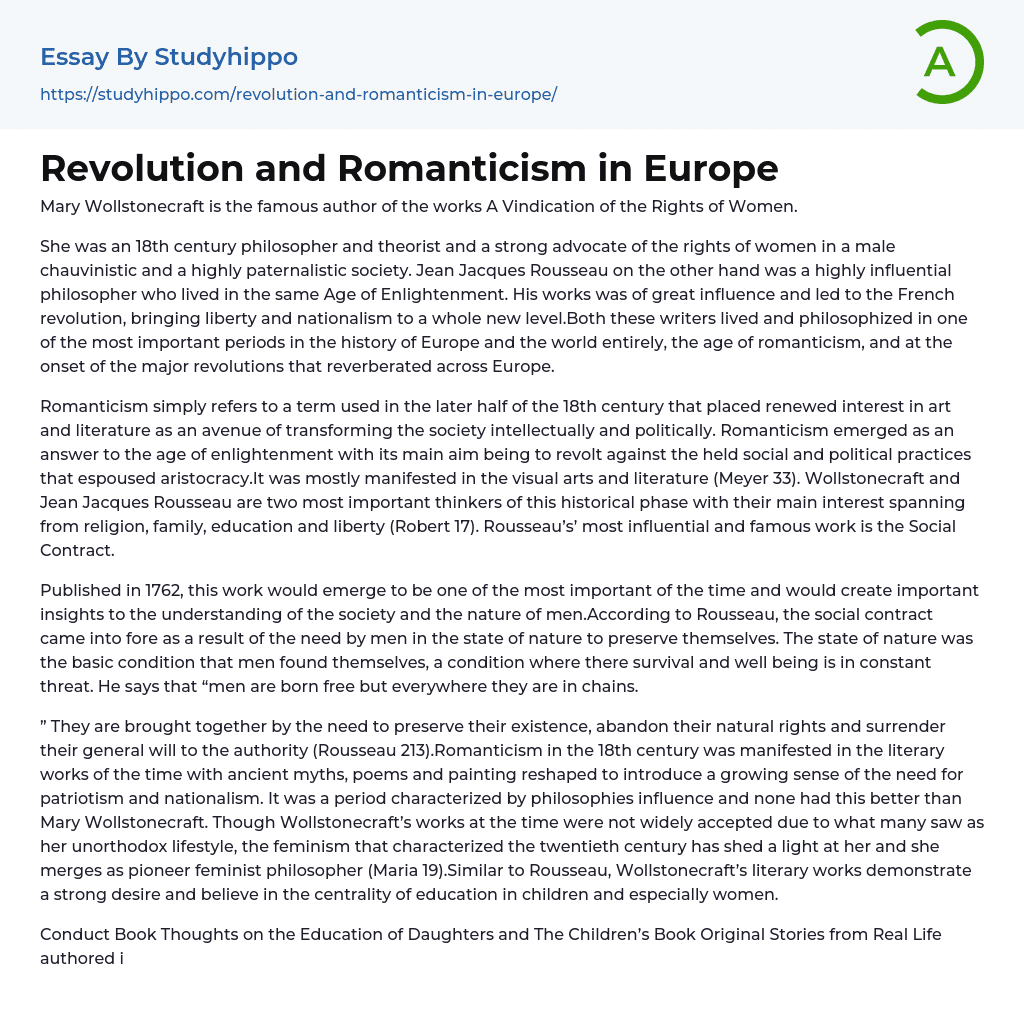Mary Wollstonecraft is well-known for her book titled A Vindication of the Rights of Women.
Two significant writers emerged during the era of romanticism and amidst major European revolutions. One was a philosopher advocating for women's rights in an 18th-century society dominated by men, while the other was Jean Jacques Rousseau, whose works greatly impacted the French Revolution and sparked heightened levels of liberty and nationalism. Despite their contrasting perspectives, both lived and philosophized during a crucial period in world history.
During the late 18th century, a new movement called Romanticism emerged with a renewed interest in literature and art. The primary goal was to challenge social and political norms promoting aristocracy as a response to the Age of Enlightenment. This movement aimed at transforming society intellectually and politically. Literature and visual arts were the most common forms of expres
...sion for this movement. The key thinkers of this phase were Wollstonecraft and Jean Jacques Rousseau, who focused on religion, family, education, and freedom. Rousseau's renowned work is The Social Contract.
During 1762, an influential work was published that provided important insights into society and the essence of human beings. Rousseau suggested that the social contract originated from the need for individuals to safeguard themselves while in a state of nature. This basic state put individuals at constant risk, jeopardizing their survival and well-being. In Rousseau's view, "Man is inherently free but everywhere he is in bondage."
According to Rousseau (213), individuals unite to preserve their existence, relinquish their natural rights, and submit their general will to authority. In the 18th century, Romanticism was evident in literature through the remodeling of myths, poems, and art to foster patriotism and nationalism
Mary Wollstonecraft exemplified the influence of philosophy during this period, despite the lack of widespread acceptance of her works due to her unconventional lifestyle. However, her contribution to feminist philosophy has been recognized in the 20th century as she emerges as a trailblazing pioneer (Maria 19). Like Rousseau, Wollstonecraft strongly advocates for the importance of education, especially for women and children, as evident in her literary works.
Two significant texts advocating for girls' education are the late 1780s works of Conduct Book Thoughts on the Education of Daughters and The Children’s Book Original Stories from Real Life. The author argues against the beliefs of Rousseau and John Locke, stating that educating girls would lead to the creation of good wives who would make noteworthy contributions to society. While Rousseau acknowledges the importance of education for both boys and girls, he believes that boys' education should focus on self-reliance, whereas girls should be educated to be governed by men. He maintains that women should be subordinate to men and taught accordingly through education (Alan 26).
Within Romanticism, there was a focus on breaking away from previously held conservative ideas in society. Wollstonecraft emphasized this through her forceful criticism of the aristocracy and monarchy, and her call for a move towards Republicanism. In her work, A Vindication of the Rights of Men, she was viewed as being influenced by Enlightenment thinkers. Similarly, Rousseau's political theory prioritized the importance of liberty and individual rights for everyone in society.
The thoughts of a philosopher emphasized the importance of contractual rights and attacked the rule by aristocrats. These ideas greatly influenced the French and American revolutions. Christopher noted that equal rights should
be extended to all members of society. The prevailing environment of Europe during the Enlightenment heavily influenced the themes and ideas espoused by these two theorists. There was a widespread desire to move towards liberalism and transform existing leadership models.
During a period of turmoil in Europe, the monarchy and aristocratic system had become autocratic and inefficient. Romanticism was beginning to replace long-held traditions, paving the way for a new system. This shift would eventually lead to the French and American Revolution.
Rousseau's ideals and Wollstonecraft's works exemplify the popular themes of the time, including family, education, and liberty, among others.
- Acceptance essays
- Age Of Enlightenment essays
- Child Observation essays
- Confucianism essays
- Conscience essays
- Critical Reflection essays
- Destiny essays
- Determinism essays
- Empiricism essays
- Environmentalism essays
- Epistemology essays
- Ethics essays
- Ethos essays
- Existence essays
- Existentialism essays
- Fate essays
- Free Will essays
- Functionalism essays
- Future essays
- Good And Evil essays
- Human Nature essays
- Individualism essays
- Meaning Of Life essays
- Metaphysics essays
- Natural Law essays
- Personal Philosophy essays
- Philosophers essays
- Philosophy Of Life essays
- Political Philosophy essays
- Pragmatism essays
- Reality essays
- Relativism essays
- Teaching Philosophy essays
- Time essays
- Transcendentalism essays
- Truth essays
- Utilitarianism essays
- Cuban Missile Crisis essays
- Fidel Castro essays
- French Revolution essays
- Han Dynasty essays
- Hiroshima essays
- Imperialism essays
- Jack The Ripper essays
- Mao Zedong essays
- Middle Ages essays
- Mongols essays
- Nelson Mandela essays
- Ottoman Empire essays
- Reformation essays




